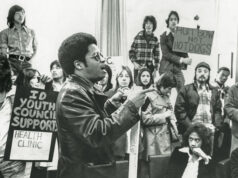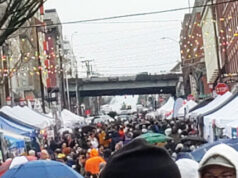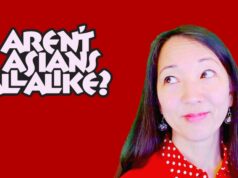Partnership for the Future for the Japanese American Community
By Calvin Terada
NAP Contributor
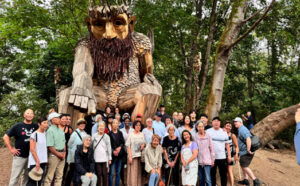
Seattle Hiroshima Club and Seattle Kumamoto Kenjin Kai visiting the Vashon Troll after visiting Japan Festival at Mukai Farm & Garden. Photo credit: Kumamoto Kenjin Kai.
On Saturday, September 7, 2024, multi-generational members of the Seattle Hiroshima Club and Seattle Kumamoto Kenjin Kai in Washington boarded a bus to travel together visiting and supporting the fifth annual Japan Festival at the Mukai Farm and Garden on Vashon Island in Washington. It seemed fitting that two of the oldest kenjin kai or Japanese prefectural alumni associations in the Pacific Northwest decided to work together to support this “younger” organization and event. “There is nothing more fitting to showcase solidarity and support to our fellow community organization by supporting their event with a bus full of people,” said Tina Terada. She is the event leader and vice-president of the 117-year-old Seattle Kumamoto Kenjin Kai. The one-day bus trip started by gathering at the Seattle Betsuin Buddhist Temple then a short commute to the Japan Festival, and it concluded with a visit to the Vashon Troll at Point Robinson Park.
 ◀︎ Children selecting a balloon in the Kids Village at Japan Festival on Vashon Island in Washington State.
◀︎ Children selecting a balloon in the Kids Village at Japan Festival on Vashon Island in Washington State.
Spearheaded by Patsy Yamada, Seattle Fukushima Club, attendees regularly see a table of kenjin kai organizations conducting outreach at community events in Washington like the Seattle Cherry Blossom Festival, Cultural Day at the Japanese Cultural and Community Center of Washington, Bellevue Japan Fair or Japan Week at Bellevue College. “The idea of working together to serve our community will likely be the start of additional joint programming opportunities between our kenjin kais,” said Calvin Terada, president of the Seattle Kumamoto Kenjin Kai. He went on to say that these types of joint programming will better benefit our community because it will create more opportunities to learn about the Japanese and Japanese American culture in our area.
Since 1893 when the first Japanese workers disembarked in Tacoma, Washington the Consul General of Japan at the time encouraged people from various prefectures to create kenjin kais. These alumni associations have existed to help support their members in many ways. “Today is a historic day for our organizations because it is the first time our two organizations are working together to teach our membership about the past and building connections for the future,” said Terada.
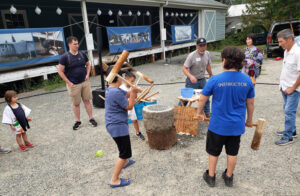
Mochi pounding (pounded rice) the traditional way in front of the former Mukai Cold Process Fruit Barrel building at Japan Festival on Vashon Island in Washington State. Photo credit: Barbara Mizoguchi.
In the early days, the primary role for the kenjin kais was to help individuals and young families learn how to adapt and integrate as recent immigrants to the Pacific Northwest. Now, kenjin kais are having to adapt so that they can help to serve as guides showcasing the greater community the Japanese and Japanese American culture. The Seattle Hiroshima Club, “is the oldest kenjin kai in the Seattle area that started in 1901. So it is really critical to adapt the focus and mission of these important cultural organizations to meet the current needs of our community,” said Curtis Nakayama, president of the Seattle Hiroshima Club.
After six generations since the first Japanese immigrated to the United States, it is common to have members with one set of ancestors from one part of Japan and the other set from another part of Japan. “For me, personally, my wife’s family is primarily from Hiroshima and so, technically, we should be members of both the Seattle Hiroshima Club and Seattle Kumamoto kenjin kai. But it is traditional to only join one group or another,” said Terada. Nowadays, it is more common to have membership in more than one kenjin kai also because the organizations are much more open and supportive of each other. While working in the traditional ways they are also looking for new ways to tell the Japanese and Japanese American story and serve our community. For example, the Japanese Cultural and Community Center of Washington recently embarked on a new project to create a dedicated kenjin kai webpage so that individual organizational stories can be preserved, but share a common platform. Organizations are always stronger working together to fulfill their common mission.
(The Mukai Farm and Garden was founded in 1926 as a strawberry farm by first generation Japanese pioneer B.D. Mukai.)

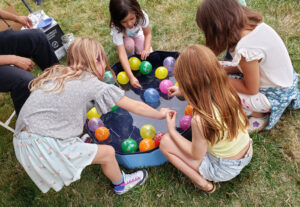 ◀︎ Children selecting a balloon in the Kids Village at Japan Festival on Vashon Island in Washington State.
◀︎ Children selecting a balloon in the Kids Village at Japan Festival on Vashon Island in Washington State.